In humans, the gut or other worms are an invasion that affects the whole body. The disease is caused by infection of worm eggs and larvae and is characterized by a number of specific symptoms.
The diagnosis is made by several tests, both feces and blood. Worms in the abdomen and other organs occur in adults and children, may appear in the anus, feces, or do not manifest themselves at all.
Reasons
In the intestines, worms are mainly transmitted by fecal-oral route, ie the eggs of the parasites or the larvae of the worm must be swallowed in order to become infected. The unfortunate feature of this invasion is that some types of helminths in children and adults retain their viability outside the host's body (eg, water, soil) for a long time.
The eggs of the parasites laid by the adults remain viable for several months. This feature makes some types of worms very common in children and adults.
The main routes of infection are:
- Infection with the use of untreated water in a well, a natural reservoir and even tap water. In humans, almost all intestinal parasites live and multiply in water for a long time, so it is better to drink bottled water. In areas unsuitable for sanitary conditions, the water in the well can be used only after boiling for a long time;
- The appearance of a worm on the baby's hip can occur as a result of eating poorly washed vegetables. If manure is used to fertilize soil infested with worms, their larvae, eggs and adults emerge and live in the soil for a long time. Along with the soil particles, the eggs fall on the vegetables. If such a vegetable is poorly washed, then it will enter the body of the host, causing helminthic invasion in a person;
- Swelling and other characteristic signs of infection can occur after eating contaminated meat, fish or poultry. If an animal, bird, or fish suffers from a helminthic infection throughout its life, its flesh is also infected, and parasites (such as fish) can easily take root in the human body. You can get rid of them only as a result of careful and long-term heat treatment of the meat (boiling or frying at maximum temperature). You can also defeat the invasion by freezing. However, since most modern household freezers are capable of a maximum temperature of about 8 degrees, meat, fish, or poultry must be stored there for at least a week;
- In humans, signs of worm infestation may appear after contact with a pet. Dogs and cats roaming the streets almost always have worms in their stomachs (domestic cats are usually not infected). While performing hygiene procedures, the animal spreads the worm's eggs from the anus to the entire coat. If you kiss such an animal or do not wash your hands after contact with it, worms can form in the human body, because animal invasions take root and multiply in the human body;
- A person may see swelling and other signs of helminths after swimming in an infected pond. This is a very rare method, but infection is possible;
- In humans, the transmission of helminthiasis from one individual to another occurs through surfaces, towels, and linen. Eggs and larvae pass from the skin of an infected person to the surface or tissue, and when touched, from there to the skin of a healthy person. After that, they are likely to enter the mouth of a healthy person and develop an infection.
It should be remembered that many types of intestinal parasites are common in groups of children. This is because many children are not very concerned about hygiene, and although many surfaces in kindergartens are covered with helminth eggs, the photo below shows that even though only one child is initially ill.
For this reason, the main task of parents is to explain to the baby that all kinds of human worms are dangerous and can remain on the skin of the hands and enter the mouth. For this reason, good hygiene is important. At the end of the material there is a video about the spread of worms in women, men and children and their developmental characteristics.
Assortments
Some patients are interested in how to visually determine the color of worms and what is in the feces? Often these are white or light worms, although sometimes transparent worms are also found in humans. They are flat or round, sometimes with two dark food channels.
- The largest human worms are called tapeworms. The largest bull tapeworm in this group. According to scientific studies, they can live in the intestines for up to 40 years and reach several meters in length.
- Roundworms are the most common type of pest belonging to roundworm nematodes. Can such people be too big? Females reach a length of about 25 cm, males - 12 cm;
- Pinworms are more common in children than in adults. These are small individuals that look like roundworms, but are smaller. The largest pinworm hardly reaches 10-12 cm;
- Giardia is the smallest type of parasite. This is quite common. If it is found in the stool, you need to think about what to do with the worms and start choosing treatment;
- Trichinosis invasions are characterized by the most severe course, there is fever and facial edema. Such invasions are said to be caused by Trichinella nematodes.
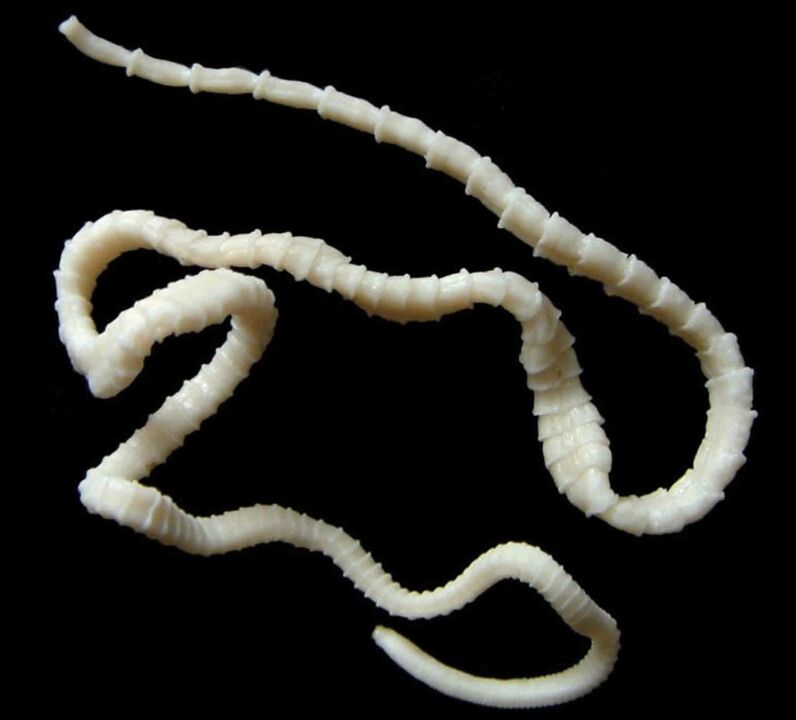
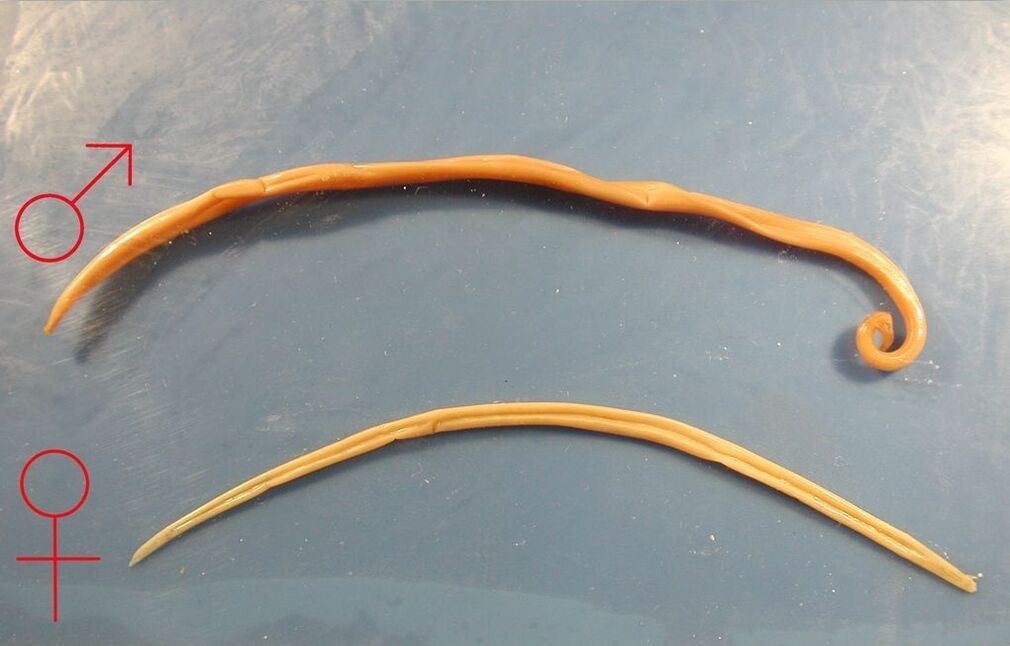
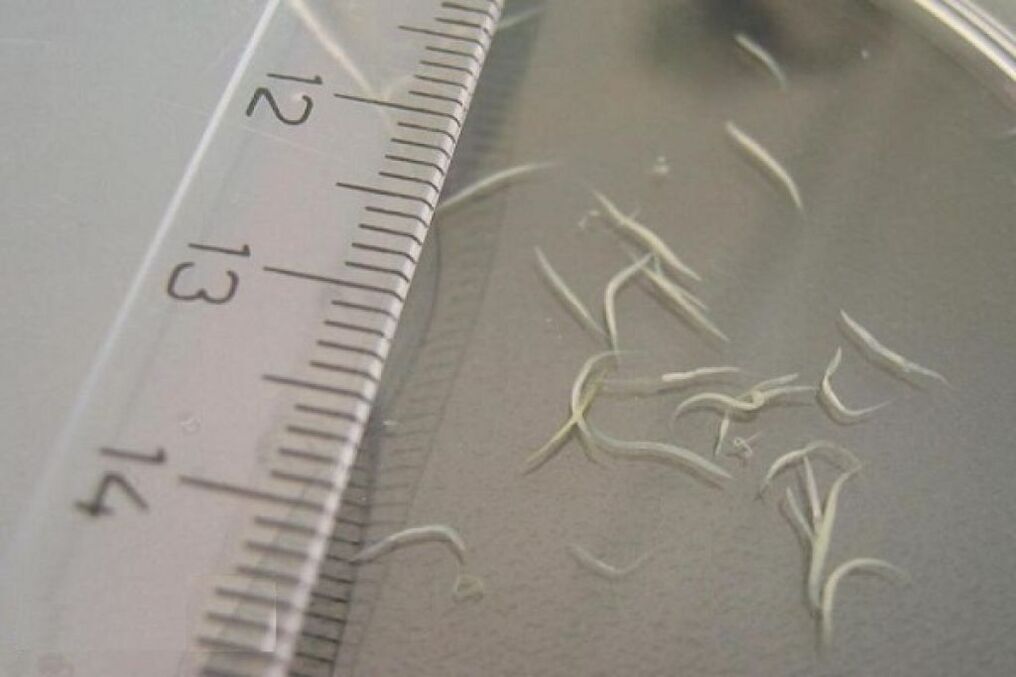
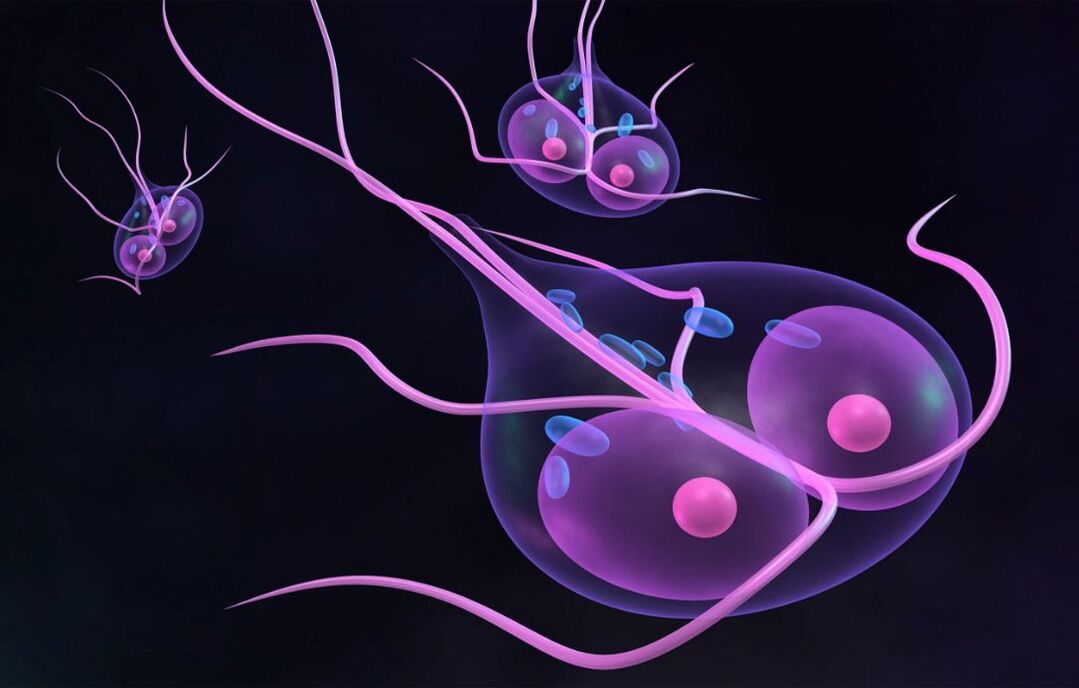
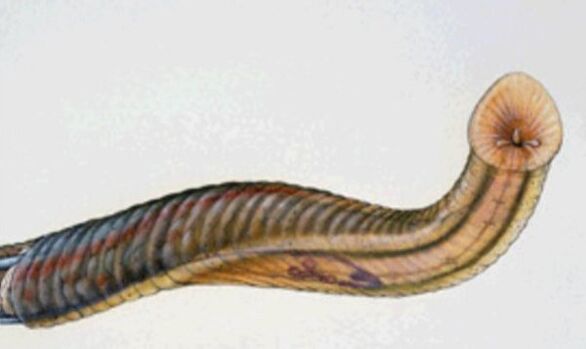
The most common types of individuals have common features and appear in the feces. Therefore, the feces of a person with worms can be distinguished from the feces of someone who is not infected.
Localization
Some people who suspect an invasion are wondering where the worms are localized in the human body? Although it is traditionally believed that worms form in the human body in the intestines, this is not entirely true.
In humans, almost all types of helminths can develop in many organs and systems, due to the characteristics of their migration, the larvae that hatch from eggs in the intestine enter the bloodstream and spread throughout the body.
They enter the human body through the mouth, but their manifestation can occur in the following places:
- Subcutaneous parasites are not the most common type of tropical parasites transmitted by insects (flyflies, specific tropical ticks, etc. ). Parasites under the skin are almost never found in the middle lane, but there is a risk of infection with them in one round. Such parasites are localized under the skin only in the early stages of life, after which they can spread to the muscles;
- A common location in women is the vagina, the uterus. They can crawl there from the anus or infect the reproductive system during migration;
- Worms are also found in the ears of infants or adults, as larvae often infect the ENT organs (including the throat);
- Many worms choose the digestive system and intestines as their location. There is enough food (blood and serum) and oxygen to lead a normal life. Intestinal parasites are usually easier to treat than others. However, even if they are in a person's stomach at first, they can infect other organs over time;
- Symptoms of worms in the lungs may be confused with symptoms of pleurisy or pneumonia. However, this is a common location for worms, so it is important to diagnose their presence in a timely manner;
- If parasites appear in the brain, the nervous system is damaged. Convulsions, nervousness, unreasonable anxiety, etc. can manifest itself as;
- In humans, if worms show up in the heart, tachycardia, arrhythmias, and more are possible. Heart failure develops, especially in severe cases;
- Helminths are also common in the liver, as they pass primarily through the portal vein through the intestines.
As can be seen from the above, patients interested in where worms live in humans should consider not only the type of invasion but also the stage of infection.
Complications
It is important to know what worms cause and what will happen if you do not treat them? Worms cause general intoxication of the body, which can be very clearly expressed.
Symptoms of an allergic nature also appear, as the immune system produces histamines to protect against external invasion. In this case, it is necessary to remember what the allergic rash looks like with helminths - these are medium-sized pink spots, sometimes hives, itching, no at all.
As in the localization of the liver and when located in other organs, tapeworm in humans or another parasite, damages the mucous membrane of a small area and local inflammatory processes.
As a result, an abscess may occur (in the case of the liver, with the appearance of pus in the abdominal cavity and blood poisoning if left untreated).
As with damage to the bronchi and lungs, a cough is often seen. Then bronchitis, pleurisy or pneumonia develop, which should be treated with antibiotics, even if it is a reaction to the invasion.
Exacerbation of chronic diseases and microflora disorders can be seen with the localization of parasites in the vagina. It is believed that such a phenomenon can lead to infertility.
Symptoms
The symptoms of worms in humans are different, but they are characteristic of almost all types of parasites. However, chronic and acute infections can have different symptoms in adults. The following symptoms of an acute infection are characteristic:
- High temperature in normal general condition (up to 38 degrees);
- Fever-like chills and skin symptoms (rash);
- When the larvae are localized in the lungs or bronchi, the symptoms in the body are expressed by coughing;
- Inflammatory processes are signs of the presence of worms in the human body, so there is an increase in lymph nodes;
- Worms and allergies are associated in a person, so symptoms in the form of rashes and allergic reactions in a person are possible.
However, often the symptoms of worms in humans are intestinal, because the parasite is most localized. These are signs of worm infection in a person, for example:
- Fecal disorders - constipation or diarrhea, sometimes bloody;
- The first symptoms of worms are loss of appetite, nausea, and aversion to certain foods, which in turn leads to weight loss;
- The first signs of worms in adults may also be swelling and edema;
- Over time, pain in the abdomen and stomach develops intermittently or continuously, regardless of food intake;
- A person with worms develops general symptoms of intoxication - paleness, drowsiness, chronic fatigue, etc.
Skin parasites cause specific symptoms in adults and children. Symptoms of worms are numbness of the extremities, tingling in the skin, headache, dizziness, and less often - fever. In any case, the incubation period of worms in humans is quite long and can last from a few weeks to several months.
For this reason, the first signs of worms in a person may not appear soon. Since the presence of worms in a person can indicate almost all the symptoms of other diseases, it is often only when a person has worms that it becomes clear when they enter the feces.
Diagnostics
Even if you know what worms look like, you may not notice what they look like. Some types of worms are not visible for a long time, and the diagnosis of worms in humans cannot be made at home. The following methods are used in laboratories to determine the symptoms and treatment of worms discussed in this article:
- General blood test. If there are deviations, there may be worms. It looks like severe anemia - a significant decrease in iron and hemoglobin levels. In humans, worms cause local bleeding, permanent damage to the mucous membranes, and they are parasites that feed directly on the blood;
- If the worms are in the intestines, their waste will be in the feces. What are the signs of worms in the feces of an individual? These are adults of eggs, larvae or even parasites. Although you know what worms look like in humans, adults in feces can be identified independently;
- Where do worms come from in humans and what types of worms (protozoa, roundworms, tapeworms) are present in humans? This is because as soon as a person has worms, the immune system perceives them as a foreign invasion and tries to protect itself by producing antibodies. This method helps determine what types of worms are present and what symptoms are expected, as different antibodies are produced for each invasion.
The latter method of diagnosis is especially good because it allows you to learn about worms at an early stage, identify the types of worms, and learn how to treat worms in humans.
Treatment
Some patients who are interested in what human worms look like and how they enter the body also want to know how to treat them individually. The official drug treatment regimen for worms in adults involves a single dose of an anthelmintic drug that affects the entire body when a person has worms.
It is also advisable to repeat the course of treatment in adults 2-3 weeks after the first use of the drug. To get rid of larvae completely, small and large invasions need to be poisoned twice.
If the worms are present in children, another treatment is offered. Because the drugs are toxic, treatment in adults has a negative effect on the liver. Children are prescribed medications that can be taken in a short course (several times) to reduce the burden on the liver.
Some who are wondering how to treat worms individually prefer folk remedies when worms are eliminated naturally in adults or children.
It is believed that a mixture of ground pumpkin seeds with honey in a single proportion is effective against worms if consumed in a tablespoon every day.
Effective treatment is carried out using enemas from garlic-milk solution. You can also treat worms in the intestines by drinking a similar solution. If a person has worms, the symptoms will start to get worse after a week.
Prophylaxis
By knowing what worms come from and where pinworms come from, you can determine a list of rules that must be followed to protect yourself from worms in humans. To avoid the question "Do I have worms? ", It is worth doing the following:
- Wash vegetables and fruits thoroughly;
- Boil or fry the meat well, you can also freeze it for a long time;
- use only bottled or purified water to drink;
- Limit contact with pets and prevent helminthic infections on a regular basis;
- Wash your hands regularly, especially after being in public places.
If you suspect an infection, it is recommended that your stool be checked regularly for helminths.



























